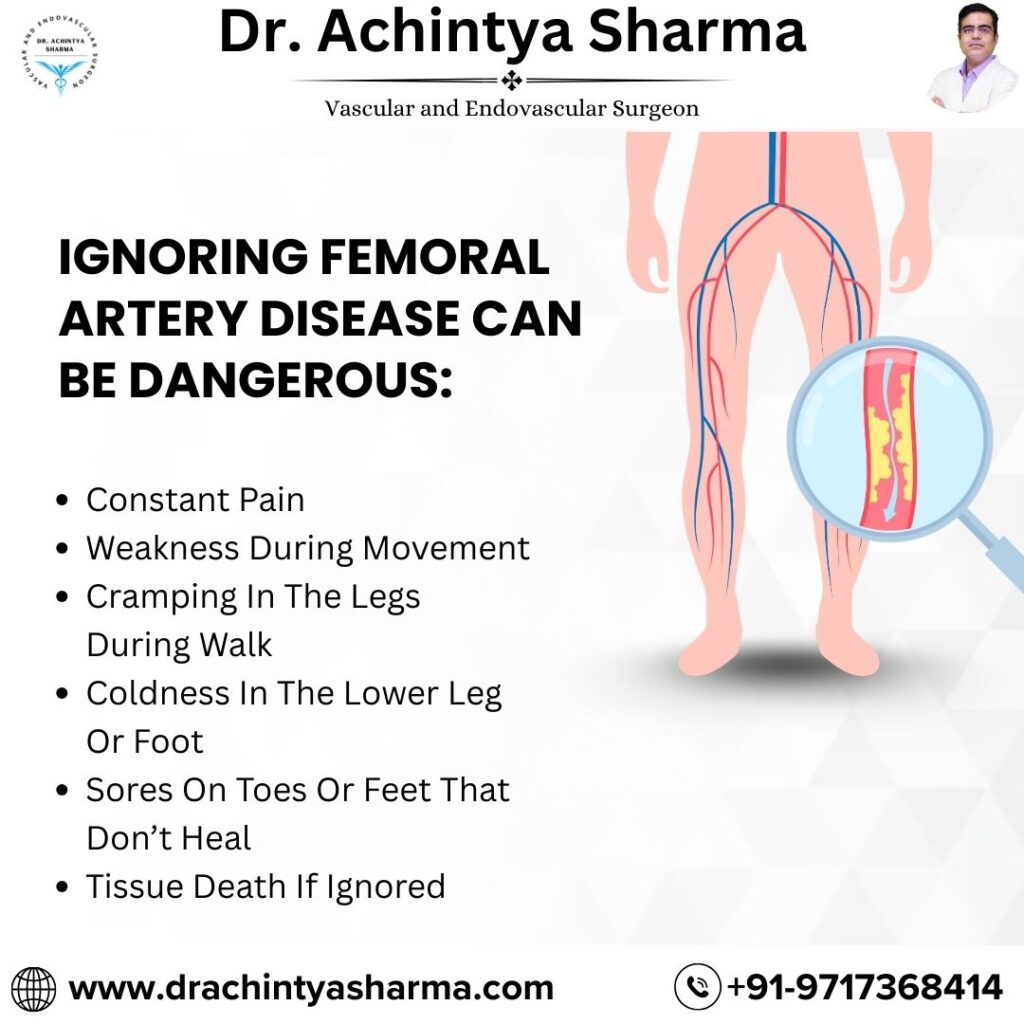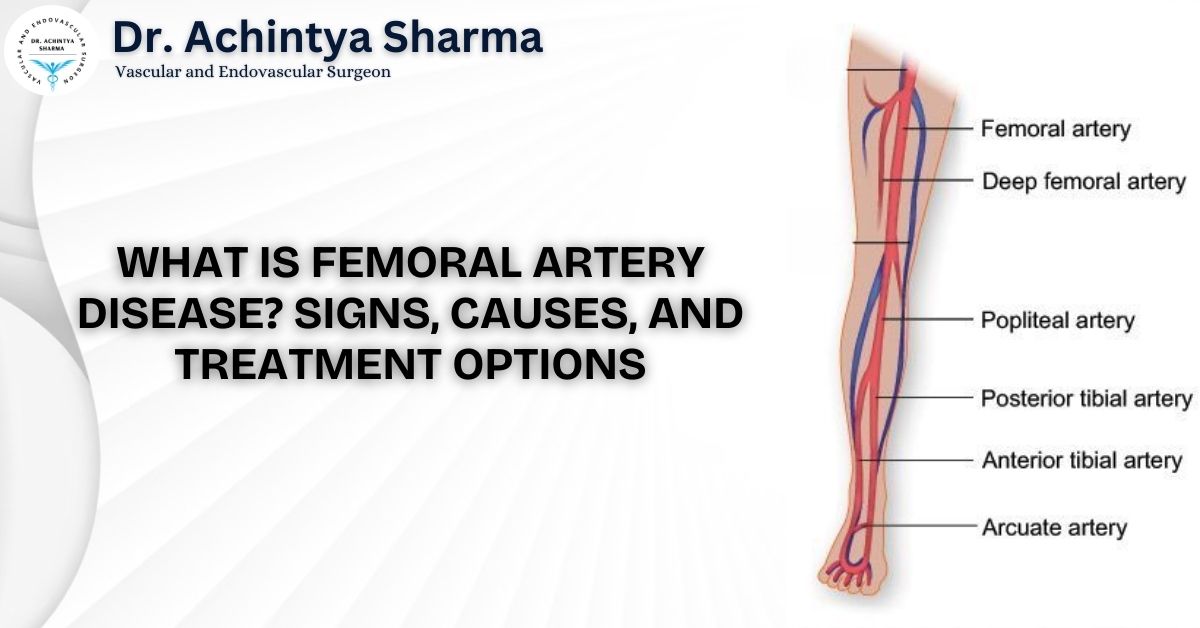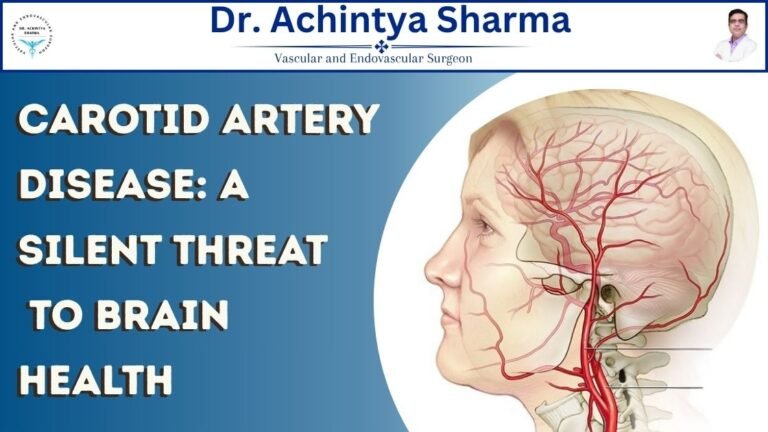Femoral artery disease is a condition where the main blood vessel in your thigh becomes narrow, reducing blood flow to your legs without obvious signs at first. This disease can lead to pain, difficulty walking, and in severe cases, limb-threatening complications. If detected early, it’s treatable and manageable. Remember, awareness is key. That’s why vascular expert Dr. Achintya Sharma stresses over early diagnosis and action. In this blog, we’ll walk you through the symptoms, causes, and treatment options in a clear, easy-to-understand way, so you can take control of your health and avoid complications.
What Is Femoral Artery Disease?
Femoral artery disease occurs when fatty deposits, also known as plaque, build up in the femoral artery—the major blood vessel in your thigh. This buildup narrows the artery and reduces blood flow to your legs. It is a specific form of peripheral artery disease (PAD) that can progress slowly and without symptoms in the early stages.
This condition is usually caused by atherosclerosis and can become dangerous if left untreated. According to Dr. Achintya Sharma, many people ignore early signs, thinking it’s just muscle fatigue or aging. That delay can cost you your mobility or worse.
Why Ignoring It Can Be Dangerous:
When your femoral artery is blocked or narrowed, your leg muscles don’t get enough oxygen, and the result is Cramping, pain, and weakness during movement. Even while walking short distances. Over time, this may lead to constant pain, wounds that won’t heal, or even tissue death.

Some warning signs include:
- Cramping or pain in the legs during walking
- Coldness in the lower leg or foot
- Sores on toes or feet that don’t heal
- Numbness or weakness in the leg
- Shiny skin or loss of leg hair
Dr. Achintya Sharma highlights that early detection can significantly reduce the risk of complications. Taking early action can lead to better results.
What Are The Main Causes Of It?
- Smoking
- Diabetes
- High blood pressure
- High cholesterol
- Obesity
- Family history of artery disease
Anyone with these risk factors should consider getting checked for femoral artery disease. A simple ankle-brachial index test can detect the condition early.
Femoral Artery Stenosis Treatment Options
Treating femoral artery disease depends on the severity of the blockage. Dr. Achintya Sharma uses a variety of methods tailored to each patient:
- Lifestyle Changes
Stop smoking, eat a heart-healthy diet, and exercise regularly. These steps help prevent further narrowing of the arteries. - Medication
Blood thinners and cholesterol-lowering drugs can manage symptoms and reduce risk. - Angioplasty and Stenting
A small balloon is used to widen the artery, and a tiny mesh tube called a stent helps keep it open. - Bypass Surgery
In more serious cases, doctors may create a new path for blood to flow around the blocked area using a bypass.
Dr. Achintya Sharma cares for his patients quickly and effectively, helping them feel better and enjoy life without pain again.
Take Your First Step Now
Don’t ignore leg pain or numbness. These symptoms could point to femoral artery disease, and delaying treatment might lead to severe complications. Early diagnosis and intervention can preserve your leg function and quality of life.
If you’re experiencing symptoms or have risk factors, it’s time to consult a vascular expert. Dr. Achintya Sharma provides personalized, cutting-edge care for patients. His experience and patient-focused approach ensure you get the right treatment without delay.
FAQs
What happens if the femoral artery is blocked?
A blocked femoral artery can significantly reduce blood flow to the leg, leading to pain, cramping while walking (claudication), non-healing wounds, and in severe cases, tissue death or the need for amputation.
What are the symptoms of a blocked artery in your leg?
Common symptoms include leg pain while walking (claudication), numbness, tingling in the feet, coldness in the lower limbs, slow-healing wounds, and weak pulses in the legs.
Femoral artery stenosis treatment?
Treatments include lifestyle changes, medications, angioplasty with stenting, or bypass surgery. Dr. Achintya Sharma offers customized treatment plans for every stage of femoral artery disease.
Conclusion
Femoral artery disease is serious but treatable. Recognizing the signs early and acting quickly can help you avoid major health problems. Understanding the signs, knowing your risks, and getting expert help are the first steps. Whether through simple lifestyle changes or advanced medical procedures, help is available. Trust specialists like Dr. Achintya Sharma, who bring both skill and compassion to patient care. Don’t wait until the pain becomes unbearable. Be proactive about your vascular health, and take steps today to walk pain-free tomorrow.




